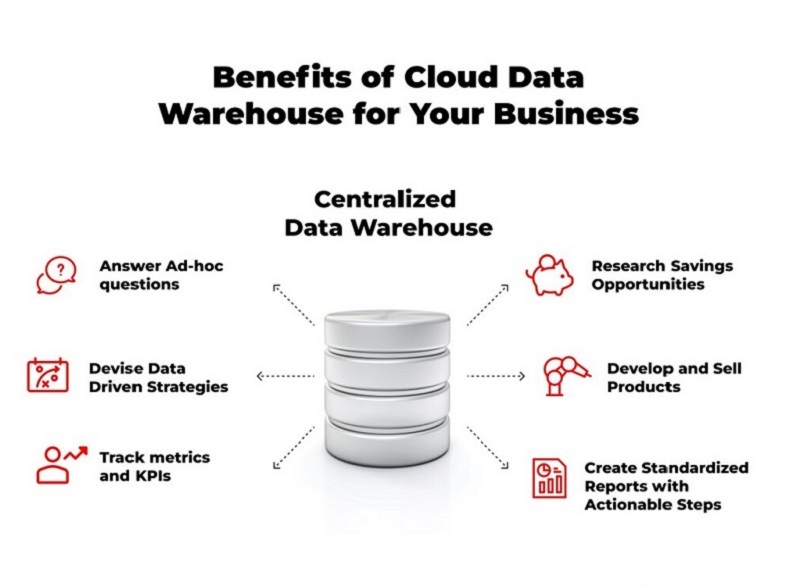Introduction
Currently, certain technological developments have arisen, particularly in the realm of cloud-based data warehousing. Organizations and associations use cloud-based data warehousing to store substantial volumes of data. Nevertheless, this particular kind of data warehousing has several hazards and obstacles, including issues over privacy. Data breaches, virus assaults, and data theft pose significant security concerns that contravene legislative privacy regulations, such as the Consumer Privacy Act. These downsides of Cloud Data Warehouses may be managed by the implementation of measures such as contractual agreements and data ownership.
This research primarily aims to examine the security and privacy obstacles encountered in cloud-based data warehousing used by both commercial and government entities. Key obstacles include intricate cloud computing models, the ever-changing structure of the industry, and networked systems. The main significant risk of cloud data warehousing faced by organizations is the need for more resources, which is with budgetary concerns.
Overview: Downsides of Cloud Data Warehouses
Having all the best notions and connected know-how, the corporate revolution outdoes the competencies of inheritance explanations. Methods with newer needs, data kinds, data capacities, and user belongings that are not even imaginary when such solutions are initially presented. In today’s digital epoch, heritage data warehouses fight several risks related to cloud data warehousing.
- The increased diversity of data types poses a challenge for conventional relational data systems, as their rigid structure becomes difficult to handle when attempting to accommodate new data forms.
- The presence of a substantial amount of data has significant drawbacks for Cloud Data Warehouses, resulting in performance degradation when dealing with intricate querying demands.
- The growing need for unprocessed, unmodified data to accommodate the extensive range of developing analytics is causing a shift in the conventional ETL method of entering data into the warehouse.
- Conventional on-premises data warehousing technologies and methodologies are associated with a substantial overall cost of ownership and need specialized and costly expertise to sustain the infrastructure.
- The presence of fragile architecture poses a hindrance to the IT department’s capacity to promptly adapt and implement new use cases while ensuring the inclusion of all needed features.
Benefits of Cloud Data Warehouses

1) These days, most business organizations are adopting cloud data warehouses, which provide a myriad of advantages. Data warehouses can dramatically change a business. Moreover, cloud data can be accessed and dealt with data with ease. Scalability is one of the imperative advantages of cloud data. Users should keep in mind that it is not like other services that are provided within the precinct of a business. This data cloud lets business organizations compute power and maintain a storage system. It will also help house oscillating volumes of data without any hassle.
2) However, data warehouses provide increased flexibility to the users. Companies can adjust to the requirements of changeable data in no time. It is also essential to bear in mind that businesses can change the dynamics of the market by operating complicated queries, adjoining innovative sources of data, and bringing about profound knowledge. The skill will help business companies make decisions in the fastest possible time. A day will come when the skill will stand out in the crowd and make a perfect place in the business market.
3) A prominent advantage ROI of cloud data warehouse is that you can use it at a standard price. Users can remove the requirement of investments that are used in infrastructure and hardware streams. Data warehouses can also remove the maintenance expense that is being continued and connect it to the actual data warehouse. Users need to pay for the resources they make use of. It is equally necessary to know that a business can optimize its expenses. At the same time, it can deal with the budget effectively.
4) On top of all, users can expect improved security. It is a trustworthy data service that users can use without any worries. Cloud data professionals incorporate decisive measures of security so that users do not have to face any issues. Every business can make use of a high level of protection to secure the business. Business owners can tackle every type of detail.
The World of Data Warehouses in the Cloud
The compressions that take place through the business’ wish for data empowerment, independent assistance, data-oriented understandings, and digital variations. They are creating several companies to restart their data accumulation explanations, and sellers have answered with new cloud data warehousing knowledge that offers:
Adaptability
There is a lot of reasonable and precise acceptance of fresh data and the best analytics user cases. When a corporation uses Key Success Indicators (KPIs) to assess its success, these KPIs often influence business conduct, outcomes, and the overall culture of the organization without giving any limitations on cloud Data Warehouses.
Scalability
The capacity to flawlessly meet the increasing requirements of the corporation. This might comprise the combination of larger servers, the augmentation of network capacity, or the use of cloud-based solutions that can be readily adapted to accommodate changes in demand.
Performance
Encountering SLA’s functional needs and the monetary economic limits together. Typically, Service Level Agreements (SLAs) are established between organizations and third-party vendors. However, they may also exist among two within-company divisions.
Reusability
Preserving more significant data in the unique, not-so-changing condition for additional application and worth. The outcome is a reduced time required to get insight and eliminates the need for rework in response to the emergence of new data, descriptions, or needs.
Some Vulnerability and Limitations of Cloud Data Warehouses
Cloud environments are subject to similar dangers as conventional data center settings, resulting in a comparable threat landscape. Cloud computing operates on software, which in turn includes weaknesses that enemies attempt to exploit. In contrast to conventional data center information technology systems, cloud computing entails a shared duty between the Cloud Service Provider (CSP) and the cloud user in addressing the risks associated with software vulnerabilities.

Consequently, customers need to comprehend the allocation of duties and place their faith in the CSP’s ability to satisfy their obligations. Through an extensive review of relevant studies and rigorous research, we have established a comprehensive compilation of the risks of cloud data warehousing. Below, we provide a comprehensive overview of the potential downsides of cloud data warehouses that are faced by such systems.
1. Configuration Errors
Malfunctions refer to inaccuracies in the security setups of cloud-based applications and structures, such as containerized systems, virtual machines, serverless circumstances, and architecture as code. Misconfigurations are the most significant Disadvantages of Cloud Data Warehouse and often arise as a result of human mistakes, rapidly changing circumstances, insufficient knowledge, and erroneous assumptions about safety.
Misconfigurations are primarily responsible for data breaches. Typical cloud misconfigurations involve the presence of open ports for outgoing server traffic, overprivileged identities, inadequate surveillance, insecure storage (such as open S3 buckets), the use of default usernames and information, and misconfigurations related to third-party organizations. To avoid the Drawbacks of a Hybrid Data Warehouse, here, you must use the cloud security bearing system (CSPM) technology to review frequently and remediate cloud shapes and gadgets most limited treat access to cloud possessions.
2. Absence of Discernibility
Companies do a mixture and tie cloud skills from numerous workers ad hoc, making multifaceted, unified, and continually developing IT atmospheres. Cloud safety risks of dissimilar sizes might get dispersed all through this lively substructure. Inappropriately, an absence of discernibility could be harmful to classifying, contextualizing, ordering, and justifying such weaknesses. It’s unbearable to measure the danger of cloud computing susceptibilities deprived of central, content-type perceptibility of the complete cloud network. To avoid the drawbacks of a hybrid data warehouse, one must start executing centralized cataloging and examining answers for each of the cloud capitals, as well as frequently appraise and prune needless incomes.
3. Bad Access Administration
Digital individualities massively outstrip humanoid characters in cloud surroundings, which creates a tempting board for dangerous performers. Uniqueness admission administration and additional identic kind cloud exposures could be strong initial outbreak trajectories for cybercriminals to penetrate an IT atmosphere, exfiltrate data, and reason for any harm. Companies can accept MFA and Single Sign-On (SSO) explanations and perform working out meetings for correct admittance administration performances.
4. Mirror IT
Mirror IT is an authorized platform whereby workers on both personal and professional accounts use the personal account to engage in unsafe data-sharing practices. Illustrations of this technological advancement include Google Drive, Gmail, Slack, and OneDrive.
A comprehensive data protection system that offers total visibility into all data transfers and dynamically evaluates security threats based on the context of the file and user, rather than only focusing on the final destination, is considered the most effective approach for detecting mirror IT.
5. The failure of separation among many connections
The inability to maintain separation among tenants may occur when system and software vulnerabilities inside a CSP’s infrastructure, platforms, or applications that allow multi-tenancy are exploited. The occurrence of this failure may be used by an assailant to illicitly get entry from the resources of one entity to the assets or data of another user or business. The implementation of multi-tenancy results in an expanded attack surface, hence augmenting the likelihood of data leakage in the event of failure in the separation mechanisms.
Conclusion and Key Takeaways
In conclusion, circumnavigating the area of cloud data warehouses could have huge drawbacks to a hybrid data warehouse, and it can be intricate and thought-provoking. Even with the appropriate cloud data warehousing solutions and groundwork, you can still get hidden risks that might delay the achievement of the data projects. By knowing the typical limitations of cloud data warehouses, such as data security, incorporation questions, scalability worries, and performance blockages, you can upfront discuss such problems and guarantee the finest process for any firm’s cloud data warehouse.
FAQs
1. Under what circumstances should Cloud Storage be avoided?
The reason is the potential consequence of a hacker gaining control over a cloud storage provider is the probable loss of access to submitted data.
2. What is the most optimal Cloud Data Warehouse?
Azure SQL Database, Snowflake, and Azure Cosmos are the best cloud data warehouses.
3. What are the Data Warehouse’s drawbacks?
Data warehousing architecture may suffer from poor data quality, difficult integration procedures, scalability issues, expensive installation costs, and obsolescence when business demands change.
4. How often do Data Warehouses fail?
Data Warehouse initiatives fail over 80%, according to recent research. This might be attributed to not providing commercial value or seeing them as technological initiatives.





